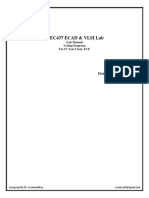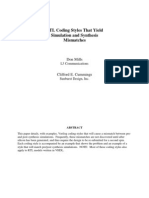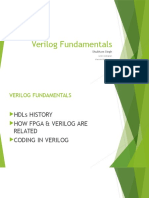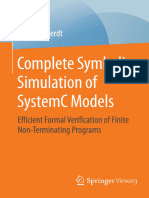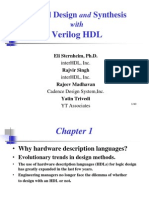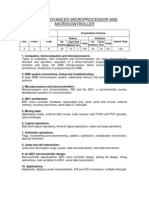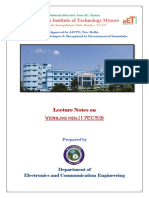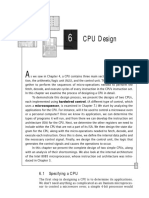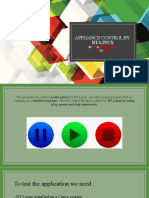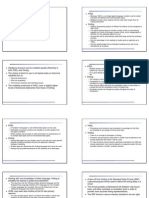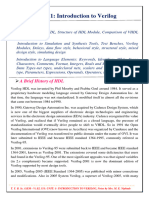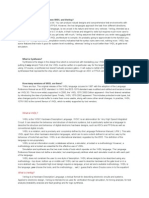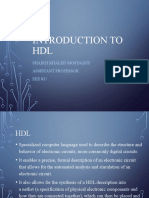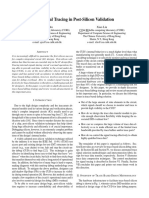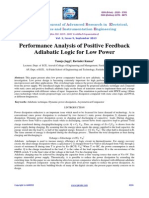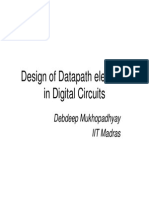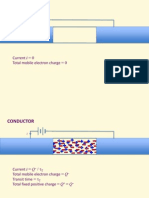Digital Simulation White Paper
Comparison of VHDL, Verilog
and SystemVerilog
Stephen Bailey
Technical Marketing Engineer
Model Technology
w w w. m o d e l . c o m
Introduction
As the number of enhancements to various
Hardware Description Languages (HDLs) has
increased over the past year, so too has the complexity of determining which language is best for
a particular design. Many designers and organizations are contemplating whether they should
switch from one HDL to another.
This paper compares the technical characteristics
of three, general-purpose HDLs:
VHDL (IEEE-Std 1076): A general-purpose digital design language supported
by multiple verification and synthesis
(implementation) tools.
Verilog (IEEE-Std 1364): A general-purpose digital design language supported by
multiple verification and synthesis tools.
SystemVerilog: An enhanced version of
Verilog. As SystemVerilog is currently
being defined by Accellera, there is not
yet an IEEE standard.
General Characteristics of the Languages
Each HDL has its own style and heredity. The
following descriptions provide an overall feel
for each language. A table at the end of the
paper provides a more detailed, feature-by-feature comparison.
VHDL
VHDL is a strongly and richly typed language.
Derived from the Ada programming language, its
language requirements make it more verbose
than Verilog. The additional verbosity is intended to make designs self-documenting. Also, the
strong typing requires additional coding to
Comparison of VHDL, Verilog, and SystemVerilog
explicitly convert from one data type to another
(integer to bit-vector, for example).
The creators of VHDL emphasized semantics
that were unambiguous and designs that were
easily portable from one tool to the next. Hence,
race conditions, as an artifact of the language
and tool implementation, are not a concern for
VHDL users.
Several related standards have been developed to
increase the utility of the language. Any VHDL
design today depends on at least IEEE-Std 1164
(std_logic type), and many also depend on standard Numeric and Math packages as well. The
development of related standards is due to
another goal of VHDLs authors: namely, to produce a general language and allow development
of reusable packages to cover functionality not
built into the language.
VHDL does not define any simulation control
or monitoring capabilities within the language.
These capabilities are tool dependent. Due to
this lack of language-defined simulation control
commands and also because of VHDLs userdefined type capabilities, the VHDL community
usually relies on interactive GUI environments
for debugging design problems.
Verilog
Verilog is a weakly and limited typed language.
Its heritage can be traced to the C programming
language and an older HDL called Hilo.
All data types in Verilog are predefined in the
language. Verilog recognizes that all data types
have a bit-level representation. The supported
data representations (excluding strings) can be
mixed freely in Verilog.
Simulation semantics in Verilog are more
ambiguous than in VHDL. This ambiguity gives
designers more flexibility in applying optimizations, but it can also (and often does) result in
race conditions if careful coding guidelines are
not followed. It is possible to have a design that
generates different results on different vendors
tools or even on different releases of the same
vendors tool.
Since SystemVerilog is a more general-purpose
language than Verilog, it provides capabilities for
defining and packaging reusable functionality
not already included in the language.
Unlike the creators of VHDL, Verilogs authors
thought that they provided designers everything
they would need in the language. The more limited scope of the language combined with the lack
of packaging capabilities makes it difficult, if
not impossible, to develop reusable functionality
not already included in the language.
Pros and Cons of Strong Typing
Verilog defines a set of basic simulation control
capabilities (system tasks) within the language.
As a result of these predefined system tasks and
a lack of complex data types, Verilog users often
run batch or command-line simulations and
debug design problems by viewing waveforms
from a simulation results database.
The downside of strong typing is performance
cost. Compilation tends to be slower as tools
must perform checks on the source code.
Simulation, when run-time checks are enabled,
is also slower due to the checking overhead.
Furthermore, designer productivity can be lower
initially as the designer must write type conversion functions and insert type casts or explicitly
declared conversion functions when writing code.
SystemVerilog
Though the parent of SystemVerilog is clearly
Verilog, the language also benefits from a proprietary Verilog extension known as Superlog and
tenants of C and C++ programming languages.
SystemVerilog extends Verilog by adding a rich,
user-defined type system. It also adds strong-typing capabilities, specifically in the area of userdefined types. However, the strength of the type
checking in VHDL still exceeds that in
SystemVerilog. And, to retain backward compatibility, SystemVerilog retains weak-typing for the
built-in Verilog types.
SystemVerilog also adds capabilities targeted at
testbench development, assertion-based verification, and interface abstraction and packaging.
The benefit of strong typing is finding bugs in a
design as early in the verification process as possible. Many problems that strong typing uncover
are identified during analysis/compilation of the
source code. And with run-time checks enabled,
more problems may be found during simulation.
The $1,000,000 question is this: do the benefits
of strong typing outweigh the costs?
There isnt one right answer to the question. In
general, the VHDL language designers wanted a
safe language that would catch as many errors as
possible early in the process. The Verilog language
designers wanted a language that designers could use to write models quickly. The designers of
SystemVerilog are attempting to provide the best
of both worlds by offering strong typing in areas
of enhancement while not significantly impacting
code writing and modeling productivity.
Comparison of VHDL, Verilog, and SystemVerilog
Language Feature Comparison
The following table presents a feature-by-feature comparison of the three HDLs. Note that the
purple font color differentiates Verilog 2001 features from Verilog 1995 features.
VHDL
Strong typing
Yes
Verilog (2001)
SystemVerilog
No
Bit
bit-vector
wire
reg)
unsigned
signed
integer
real
String in certain contexts only
Partial
Not strongly typed in areas backward compatible with Verilog
Yes
Enhanced type system is strongly
typed (but not as strong as VHDL)
User-defined types
Yes
No
Yes
Dynamic memory allocation
(pointer types)
Yes
No
Partial
Class objects can be dynamically
created/destroyed, but via handles
(safe pointers)
Physical types
Yes
No
No
Named events
No
Yes
Yes
Enumerated types
(FSM modeling)
Yes
No
Yes
Records/structs
Yes
No
Yes
Variant/unions
No
No
Yes
Associative/sparse arrays
Partial
(But can be modeled using
access types)
No
Yes
Class/inheritance
No
No
Yes
(single inheritance)
Data packing
No
No
Yes
Bit (vector) / integer
equivalence
Partial
Not built-in but standard
package supports
Yes
Yes
User defined signal/net
resolution
Yes
No
No
Subprograms (procedural)
Yes
Function & procedure
always automatic
Yes
Static and automatic functions
and tasks
Yes
Same as Verilog plus void
functions (procedures)
Subprograms (concurrent)
aka tasks
Yes
Concurrent procedure calls
Yes
Static tasks
Yes
Static tasks
Methods
No
No
Yes
(goes hand-in-hand with classes)
Separate packaging
Yes
Packages
Yes
Include files
Yes
Include files
continues on pg 4
Comparison of VHDL, Verilog, and SystemVerilog
continued from pg 3
VHDL
Verilog (2001)
SystemVerilog
Other hierarchy
Yes
Separate entity / architecture
(Interface / implementation)
No
Yes
Programs, Clocking domains,
Interfaces
All-read sensitivity
No
Yes
@(*)
Reactive region processes
Yes
Postponed processes
No
Yes
Same as Verilog.
Plus: always_comb
Yes
Programs, Clocking domains,
Final blocks
Dynamic process
creation/deletion
No
Yes
Fork/join. Block/task disable.
Yes
Same as Verilog.
Conditional statements
Yes
If-then-else/elsif (priority)
Case (mux)
Selected assign (mux)
Conditional assign (priority)
No dont care matching capability
Yes
if-else (priority)
case (mux)
casex (mux)
?: (conditional used in
concurrent assignments)
Yes
Same as Verilog.
Adds priority and unique keywords
to infer priority encoding/mux
implementation
Iteration
Yes
Loop
while-loop
for-loop
exit
next
Can name the loop to exit or
continue with next
Yes
repeat
for
while
Yes
Same as Verilog, Plus:
do-while
break
continue
Only closest enclosing loop can
be break or continue
Operators & expressions
Yes
All expected:
arithmetic
logical
bit-wise
shift
concatenation
Overloadable (polymorphism).
No unary reduction.
No logical scalar/vector.
Yes
All expected:
arithmetic
logical
bit-wise
shift
concatenation
unary reduction
logical scalar/vector
case (in)equality.
conditional (?:)
No rotate left/right
Yes
Same as Verilog.
Plus:
wild (in)equality
increment
decrement
assignment (+=, -=, |=, etc.)
No rotate left/right
Gate level modeling
Yes
VITAL.
Very good FPGA library support.
Yes
Builtin primitives.
UDPs.
Better availability of ASIC library
support
Yes
Same as Verilog.
Except, library support yet to be
qualified as vendors wont assume
Verilog sign-off = SystemVerilog
sign-off
Interface abstraction
Partial
No
Component abstracts interface
from specific module.
Two layer binding allows flexibility
in generic/port mapping.
Yes
Interfaces are a separate
construct in language.
Supports multiple abstraction
level and eases interface reuse.
Can reduce coding.
continues on pg 5
Comparison of VHDL, Verilog, and SystemVerilog
continued from pg 4
VHDL
Verilog (2001)
SystemVerilog
Configuration & Binding
Yes
Control of instance or component
binding to entity.
Incremental (re)binding of
generics and ports.
Partial
Control of module to instance
binding.
Partial
Same as Verilog.
Conditional & iterative
generation
Yes
If (conditional)
For (iterative)
Yes
If
if-else (mutually exclusive)
case
for
Yes
Same as Verilog.
Attributes
Yes
Attributes are typed.
Attribute values can be specified.
Attribute values can be referenced.
Anything labeled with a name can
be attributed.
Partial
Not-typed.
Can be placed virtually
anywhere.
What is attributed is determined
by lexical proximity.
Attribute values cannot be
referenced.
Partial
Same as Verilog.
Groups allow attributes to relate
two or more named entities in the
design.
Verification targeted
capabilities
Partial
Access types
Recursive subprograms
Extensive File I/O
Postponed processes
Standard package for random
number generation
Limited
File I/O
Random number generation
Recursive subprograms
Fork/join
Yes
Same as Verilog.
Plus:
Random and constrained
random value generation
Programs
Clocking domains
Associative arrays
Semaphores
Mailboxes
Classes
Assertions
Partial
Combinatorial (Boolean)
assertions
User-defined severity and
message control
No
Yes
Combinatorial and sequential
(concurrent) assertions.
Sequence (temporal) expression.
Sequence-local variables.
User-defined severity and
message control.
API extensions for assertions
and coverage information for
assertions
Foreign interfaces
Limited
Standard Foreign attribute
VhPI defined, but not yet
standardized
Yes
Standard C API (tf, acc, vpi)
Yes
Same as Verilog.
Plus:
Extensions to API for assertions
and coverage
Direct C language interface
Comparison of VHDL, Verilog, and SystemVerilog
Summary
With all of the recent publicity surrounding languages and standards, many people are wondering where to go next. The answer to this question
will vary greatly by designer and organization. In
addition to the language feature comparison
above, here are some final points to consider:
SystemVerilog is an emerging standard that
is still evolving. With a compelling set of
features, SystemVerilog is the likely migration path for current Verilog users.
However, widespread tool support won't be
available until the specification stabilizes.
For VHDL users, many of the
SystemVerilog and Verilog 2001 enhancements are already available in the VHDL
language. There is also a new VHDL
enhancement effort underway that will add
testbench and expanded assertions capabilities to the language (the two areas where
SystemVerilog will provide value over
VHDL 2002). Considering the cost in
changing processes and tools and the
investment required in training, moving
away from VHDL would have to be very
carefully considered.
For more information, call us or visit: www.model.com
Copyright 2003 Mentor Graphics Corporation. This document contains information that is proprietary to Mentor Graphics Corporation and may be duplicated in whole or in part by the original recipient for internal business purposed only, provided that this entire notice appears in all copies. In accepting this document, the recipient agrees to make every reasonable effort to prevent the
unauthorized use of this information. Mentor Graphics is a registered trademark of Mentor Graphics Corporation. All other trademarks are the property of their respective owners.
Corporate Headquarters
Model Technology
8005 S.W. Boeckman Road
Wilsonville, Oregon 97070 USA
Phone: 503-685-0824
Corporate Headquarters
Mentor Graphics Corporation
8005 S.W. Boeckman Road
Wilsonville, Oregon 97070 USA
Phone: 503-685-7000

